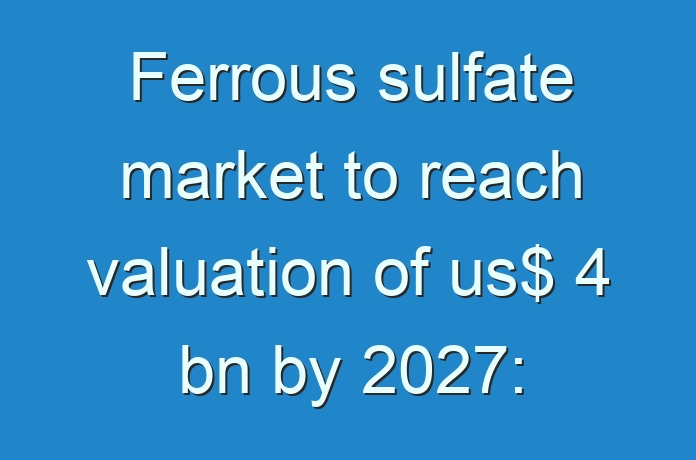
Ferrous Sulfate Market: Introduction
In terms of value, the global ferrous sulfate market is anticipated to expand at a CAGR of 3% from 2019 to 2027 and reach ~US$ 4 Bn by 2027. Asia Pacific dominated the global ferrous sulfate market in terms of volume in 2018. It is estimated to be the leading region of the global ferrous sulfate market during the forecast period. Various companies engaged in wastewater treatment are focusing on expanding their business in Asia Pacific. For instance, in February 2018, Suez SA, a France-based water treatment company, announced plans to start a drinking water production plant in Indonesia. This is anticipated to drive the ferrous sulfate market in Asia Pacific.
Ferrous Sulfate Market: Key Drivers and Restraints
Increase in usage of ferrous sulfate to treat anemia is anticipated to boost the ferrous sulfate market during the forecast period. Iron deficiency occurs when the required amount of iron decreases to low levels and the amount is not sufficient to support normal RBC production. According to the World Health Organization (WHO), in 2017, 42% of children aged less than five years and 40% of pregnant women worldwide were anemic. Ferrous sulfate is employed to treat and prevent anemia. It replenishes iron. It helps in oxygen transport and storage, electron transport, energy metabolism, and provides beneficial pro-oxidant functions.
Request a Sample-
https://www.transparencymarketresearch.com/sample/sample.php?flag=S&rep_id=64365
Rise in cases of anemia has led to initiation of iron fortification programs in various parts of the globe. For instance, more than 20 countries in Latin America have implemented mass iron fortification programs. Most of these involve the fortification of wheat or maize flours. Countries in Latin America are using ferrous sulfate as a fortificant for most of their food. Increase in usage of ferrous sulfate in the cement industry is expected to create lucrative opportunities for the ferrous sulfate market in the near future. Ferrous sulfate is primarily used as a reducing agent in the cement industry in order to reduce chromium VI to chromium III, as chromium is known to cause dermatitis (also known as cement itch).
Moreover, rise in construction activities is anticipated to boost the demand for cement, thereby augmenting the demand for ferrous sulfate. According to the U.S. Census Bureau, the U.S. Government spent US$ 1,369.2 Bn in overall construction activities in January 2024, exhibiting a 1.8% increase from US$ 1,345.5 Bn in December 2019. Ferrous sulfate carries various side effects. As a result, various alternatives of ferrous sulfate are being employed across the world. Carbonyl iron is used as a substitute for ferrous sulfate. It is highly recommended for children and women, as it has a slower release of iron. Besides carbonyl iron, ferrous fumarate and ferrous gluconate are used as alternatives for ferrous sulfate. Thus, emergence of such alternative is likely to lead to a change in preferences of customers. This is projected to hamper the global ferrous sulfate market during the forecast period.
Request for covid19 impact analysis –
https://www.transparencymarketresearch.com/sample/sample.php?flag=covid19&rep_id=64365
Ferrous Sulfate Market: Key Business Strategies
In October 2019, Kemira won the European Responsible Care Award for a project, which helped convert unutilized by-products into valuable raw materials. The company mined a landfill that contained several tons of ferrous sulfate raw material, putting almost 30 years of accumulated industrial by-products back into use in the circular economy. The company gained recognition in the market with this award. In April 2019, Venator Materials PLC acquired Tronox’s titanium dioxide (TiO2) paper laminates business. The company invested approximately US$ 8.9 Mn in the acquisition. Ferrous sulfate is a by-product of titanium dioxide. The acquisition is likely to help the company meet the increasing demand for ferrous sulfate among customers.
Competition Landscape of Ferrous Sulfate Market
Major players operating in the global ferrous sulfate market include Venator Materials PLC; Kemira; KRONOS Worldwide, Inc.; CINKARNA Celje d.d.; Gökay Group; Crown Technology, Inc.; and Verdesian Life Sciences
Global Ferrous Sulfate Market: Segmentation
Ferrous Sulfate Market, by Product
- Ferrous Sulfate Heptahydrate
- Ferrous Sulfate Monohydrate
- Ferrous Sulfate Tetrahydrate
- Ferrous Sulfate Anhydrous
- Others (including Ferrous Sulfate Pentahydrate)
Ferrous Sulfate Market, by Form
- Granule/Powder
- Liquid
Buy Now-
https://www.transparencymarketresearch.com/checkout.php?rep_id=64365<ype=S
Ferrous Sulfate Market, by End Use
- Pharmaceuticals
- Water Treatment
- Pigments
- Construction (Cement)
- Animal Feed
- Chemical Production/Intermediates
- Agrochemicals/Fertilizers
- Food & Beverages
- Others (including Electrical & Electronics, Mining, and Fish Hatchery)
Ferrous Sulfate Market, by Region
- North America
- S.
- Canada
- Europe
- Germany
- France
- K.
- Italy
- Switzerland
- Russia & CIS
- Rest of Europe
- Latin America
- Brazil
- Mexico
- Peru
- Argentina
- Colombia
- Chile
- Uruguay
- Rest of Latin America
- Middle East & Africa
- GCC Countries
- South Africa
- Rest of Middle East & Africa
- Asia Pacific
- China
- India
- Japan
- ASEAN
- Rest of Asia Pacific
The sustainability aspects have dramatically changes the raw material sourcing strategies for many businesses in the ferrous sulfate market. Players have become more responsible toward reducing or managing the waste, are adopting material informatics equipped with artificial intelligence (AI), and adopting energy-efficient production processes in order to maximize returns on invested capital.
More Trending Report-





